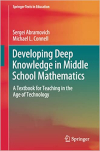- About MAA
- Membership
- MAA Publications
- Periodicals
- Blogs
- MAA Book Series
- MAA Press (an imprint of the AMS)
- MAA Notes
- MAA Reviews
- Mathematical Communication
- Information for Libraries
- Author Resources
- Advertise with MAA
- Meetings
- Competitions
- Programs
- Communities
- MAA Sections
- SIGMAA
- MAA Connect
- Students
- MAA Awards
- Awards Booklets
- Writing Awards
- Teaching Awards
- Service Awards
- Research Awards
- Lecture Awards
- Putnam Competition Individual and Team Winners
- D. E. Shaw Group AMC 8 Awards & Certificates
- Maryam Mirzakhani AMC 10 A Awards & Certificates
- Two Sigma AMC 10 B Awards & Certificates
- Jane Street AMC 12 A Awards & Certificates
- Akamai AMC 12 B Awards & Certificates
- High School Teachers
- News
You are here
Developing Deep Knowledge in Middle School Mathematics

Publisher:
Springer
Publication Date:
2021
Number of Pages:
456
Format:
Paperback
Series:
Springer Texts in Education
Price:
89.99
ISBN:
978-3-030-68563-8
Category:
Textbook
[Reviewed by , on ]
Mary Beth Rollick
10/3/2021
The authors of this book call it a textbook for developing deep understanding of middle school mathematics. The topics of the middle school curriculum, such as ratio and proportion, decimal and percent representations, are covered in the chapters as well as the unusual-for-middle-school topics of combinatorics and financial literacy. Each chapter (except for the first) ends with an Activity Set of about 22 questions that reference the information given in the chapter. The introduction of the book states that the book supports the guidelines of the Conference Board of the Mathematical Sciences (CBMS) and the Association of Mathematics Teacher Educators (AMTE). The discussions in the chapters assume that the student already has taken one or two college-level “mathematics concepts for teaching” courses where explanations and making sense of the mathematics were essential components of the course. This book might be appropriate for a math methods course or maybe a graduate mathematics education course.
The first chapter underscores the importance of understanding both concepts and procedures by presenting comments from teacher candidates and from conclusions of research studies. The goal of the textbook is to provide opportunities for teacher candidates to connect mathematics ideas as they explore middle school concepts. An effort is made not only to make connections between middle school concepts but also to connect with the mathematics already learned in elementary school and to prepare for the mathematics encountered in high school.
Many of the chapters present interesting exploration questions that stimulate curiosity and motivate perseverance. The book subtitle, “textbook for teaching in the age of technology”, does not indicate that the book relies on technology for answers but instead uses technology as a tool for exploration and as an aid for recording results so that patterns are more visible. Technology includes manipulatives, graphic organizers as well as commonly used software such as spreadsheets, graphing calculators, Wolfram Alpha, Geometer’s Sketchpad. Often a question is addressed by using conceptual strategies that encourage a “feel for numbers” and a deep understanding that is not available using just software.
The book includes an Appendix that provides guidance for setting up the spreadsheets and for programming the explorations in the chapters on algebra, patterns, and probability. Each chapter ends with a Conclusion section which includes recommended sources for deepening knowledge. The book also includes a bibliography.
The book contains quite a few typos. Many are of little consequence such as misspellings of words or names. Some are easily recognized such as noticing that c = 4 is also a solution to example 9.8 or that 3½% is not 0.036. The most troublesome error occurs in Figure 6.1 where the figure, described as “a ratio of black sheep to white sheep is 2 to 5”, but then shows 2 black rectangles and 3 white rectangles. This figure is referenced again later in the chapter stating that “for the simplest case the number of sheep is 7”. Fortunately, the text is not intended for middle-school students for whom this picture could cause part/part and part/whole misunderstandings.
This book offers an ambitious amount of material for a methods course and could be used as a sourcebook for interesting extensions of middle school topics. The chapter on Financial Literacy was a surprise. Usually, it is not included in the middle-school curriculum but the authors make a good case for teaching basic ideas about budgets and savings accounts. However, their discussion of blockchain basics and cryptocurrency seems out of place for this textbook of middle school mathematics.
Mary Beth Rollick is Professor Emerita at Kent State University, in Kent, Ohio. She continues to tutor undergraduate students and enjoys helping them to understand the “why” as well as the “how” of mathematics.
See the publisher's website.
- Log in to post comments




